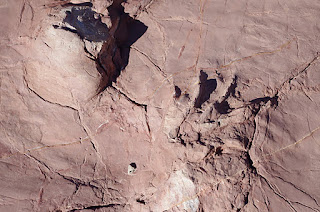Prehistoric Trackways National Monument- Discovery Site Trail


 UPDATE (July, 2021): The Ridgeline Trail has been vastly improved and now bypasses the steep climbs over several hills. The Discovery Trail has likewise been improved and actually reconnects with the Ridgeline, so a lollipop loop can be done without any road walking or off-trail hiking.
UPDATE (July, 2021): The Ridgeline Trail has been vastly improved and now bypasses the steep climbs over several hills. The Discovery Trail has likewise been improved and actually reconnects with the Ridgeline, so a lollipop loop can be done without any road walking or off-trail hiking.Our original idea was to hike Tonuco Peak, but we soon discovered that areas just to the north of Las Cruces were still covered with snow. We could see the very steep "road" to the top of the peak from the highway, and it was looking completely white. So we decided to come up with another idea. We took a few photos and headed over to the Trackways trailhead in the Robledo Mountains.
The trail ( Ridgeline Trail) followed an old road on a mesa top initially, but then took us up steeply over a couple of small peaks, before signs directed us down into the canyon containing the trackways( Discovery Site Trail). The road does continue on for a ways, up and down hills until it dead ends at big canyon. It was obviously made for fun with Jeeps back in the day which is why it goes straight up hills instead of around them.We've been here many times, but it had been quite a few years since our last visit.There is a new, large sign to read, but little else has changed.We decided to walk out down the canyon, which used to be the accepted route to the Discovery site, but since the canyon runs right next to the gravel pit site which is now a closed area, the BLM obviously would prefer visitors to use the new signed trail. We climbed back up to the new official trail eventually and returned to our car. Besides the reptile tracks and conifer impressions, there is abundant marine fossilization here as well. There is also one of the three basaltic plugs( the other two are in Apache Canyon) in the Robledos found here which all have columnar jointing on a small scale more famously recognized on a grand scale in places like Devil's Tower. It was a nice hike for a short winter day. Next time, we'll go a little further afield, the Robledos are at their best when you walk in their more remote corners.
Labels: fossils, hiking, Prehistoric Trackways National Monument
















































